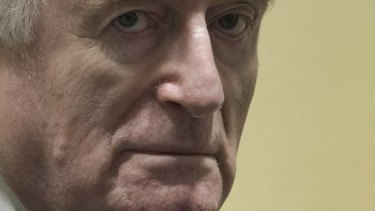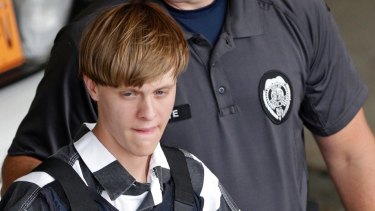Home » World News »
Christchurch shooting showed US how dangerous ‘white power’ has become
Last week Radovan Karadzic was finally sentenced for his role in the barbaric ethnic cleansing during the Bosnian War in the 1990s. The sentencing came less than a week after the massacre in Christchurch and while it may seem like these two stories have little to do with one another, they are both part of the global white-power movement that has turned Karadzic into a hero for white-power terrorists across the world.
Former Bosnian Serb leader Radovan Karadzic.Credit:AP
The global nature of violent white supremacy rarely garners much attention. In the United States, it is often understood as a distinctly American problem, a metastasised offshoot of the country's long history of racism. But the Christchurch shooting, which jolted Americans far more than news from the antipodes normally does, underscores just how global, and dangerous, the modern white-power movement has become.
The global nature of white supremacy is not unique to our time. The White Australia and White New Zealand immigration policies had counterparts in the US and Canada, where anti-Chinese bans in the late 19th century paved the way for more significant immigration restriction in the 20th century. A network of writers and policymakers built the framework for those immigration policies, all built on the shared belief in the supremacy of white people and "western civilisation".
A similar global exchange fuelled 20th-century white supremacy and anti-Semitism. The anti-Semitic text The Protocols of the Elders of Zion was written in Russia, circulated throughout Europe, and was popularised by Henry Ford in the United States. Adolf Hitler and the Nazi Party studied the American South and its system of segregation to construct their Nuremberg laws, the racial caste system that paved the way for the Holocaust.
Dylann Roof massacred nine African American worshippers as they prayed in a Charleston church.Credit:AP
In the United States, where violent white supremacy has been particularly visible in the past five years, the global nature of white power has been plainly visible, even as it has been largely ignored. In 2014, Dylann Roof massacred nine African American worshippers as they prayed in a Charleston church. In the photos of Roof that circulated in the following days, he could be seen wearing not only the Confederate flag, a symbol of domestic white supremacy, but also the flags of former Rhodesia and South Africa.
These flags, heralds of the apartheid regimes of the mid-20th century, were key symbols. Those regimes had been dismantled well before Roof was born, but in white-power circles they continued to wave, echoes of a past and hope for a future in which a white minority ruled over a black majority.
In Charlottesville in 2017, white supremacists marched on the town and a terrorist drove a car through a group of protesters, killing one and wounding dozens. An event seemingly about America's specific racist past — centred on a Confederate monument — it, too, was infused with global markers. Nazi flags commingled with Confederate ones, and medieval imagery from Europe decorated the shields and flags of the marchers.
In Christchurch, too, the white-power terrorist allegedly behind the attacks saw himself as part of both an imagined white past and a global white future. His heroes were Norwegian terrorist Anders Breivik and genocide architects like Karadzic. And while his manifesto should be understood as propaganda rather than an accurate portrait of his beliefs and radicalisation process, it does speak to tropes and arguments that are increasingly common in the global white-power movement, especially the idea of an "immigrant invasion".
The language of "invasion" has been a powerful tool for white nationalists because it has mainstream acceptance in so many countries, including Australia and the United States. In the US, it has been a prominent part of conservative pundit Pat Buchanan's rhetoric since the 1990s, and President Donald Trump uses it regularly as well.
But it is also a key component of white-power propaganda, most notably the book The Camp of the Saints, a racist novel by French author Jean Raspail. Written in 1973, its English translation quickly found fertile ground in the United States. Praised by notable conservatives, it gained some legitimacy, and continues to be promoted by prominent political figures like Steve Bannon (himself an ardent believer in a global nationalism).
It is precisely this transnational alliance of people, propaganda and ideas that leads some scholars of white supremacy to reject the phrase "white nationalism" when describing the phenomenon of violent racism now on the rise. While these ideas may march under national flags and bear distinct national accents, the nation these activists seek to support is not Australia or the United States or Britain but the Aryan nation. It is that component of the ideology that makes it a genuinely global movement.
And that is also why anti-racist opposition to white power must also be global: why political leaders, scholars, law enforcement agencies and activists from across the world must build their own international networks to thwart the rise of violent white terrorism. Not just by investigating the networks and sites of radicalisation that fuel the movement, but by talking candidly about the mainstream ideas that give it life as well.
Nicole Hemmer is a regular columnist based in the United States.
Source: Read Full Article




